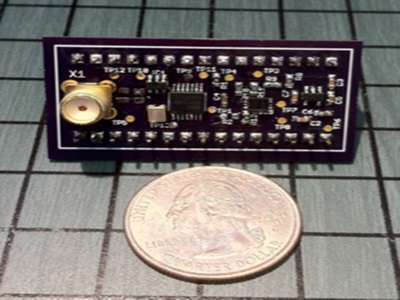Energy-Efficient Modulated Backscatter Devices for Wireless Communication
This suite of technologies offers a versatile solution for low-energy wireless communication by creating a backscatter modulation communication device capable of working directly with conventional wireless receivers without specialized hardware.

What is the Problem?
Wireless communication has transformed the way we live our lives and forms the basis of modern communications infrastructure. Energy is spent in every part of this process: a signal must be synthesized, transmitted, received, and comprehended. As devices grow smaller and the market for wearable sensors and technology grows, outfitting these devices with batteries to support these functions for wireless communication grows more and more challenging. If the energy cost of these functions could be transferred to a device more capable of expending that energy, such as a smartphone or wireless access point, it would allow for even smaller devices with increased energy efficiency.
Backscatter devices, which modulate an existing carrier wave with their own signal, offer a potential solution. However, current backscatter devices like RFID tags require specialized hardware, creating a need for more universally compatible, power-efficient backscatter communication solutions operating on standard conventional wireless protocols.
What is the Solution?
The technology is a suite of methods for backscatter modulation-based communication devices. These devices require no specialized hardware and can be picked up as conventional wireless signals. They are designed to be compatible with any Bluetooth 4.0 Low Energy (BLE) host device, using existing BLE signals as carrier waves for their own modulated signal. This results in significant energy savings compared to other BLE devices. The suite also includes an energy-efficient receiver apparatus for receiving backscatter modulated signals, a hybrid device capable of operating in either conventional or backscatter mode, and methods for working with multiple backscatter communication devices and multiplexing of backscatter modulated signals.
What is the Competitive Advantage?
This suite of technologies offers several key advantages:
- Energy Efficiency: The use of backscatter modulation significantly reduces the energy spent per bit of information sent. This is achieved by offloading the majority of the energy cost to more energy-rich devices such as smartphones and wireless access points.
- Versatility: The technology includes a hybrid device capable of operating in either conventional or backscatter mode. This allows for energy savings when possible while retaining full functionality when needed.
- Low-Energy Receiver: The suite includes an energy-efficient receiver apparatus specifically designed for receiving backscatter modulated signals, which can often be difficult to separate from the carrier wave.
- Compatibility: The technology is designed to be compatible with any Bluetooth 4.0 Low Energy (BLE) host device and can potentially be extended to other standards such as Wi-Fi (IEEE 802.11b), Zigbee (IEEE 802.15.4), etc.
- Multiplexing Capabilities: The technology includes methods for working with multiple backscatter communication devices and multiplexing of backscatter modulated signals through orthogonal frequency-division multiplexing. This offers significant power savings and low complexity.
Patent Information:
-
expand_more mode_edit Authors (1)Matthew S. Reynolds
-
expand_more library_books References (6)
- Joshua F Ensworth (2016), Ultra-low-power Bluetooth Low Energy (BLE) compatible backscatter communication and energy harvesting for battery-free wearable devices
- Daniel Arnitz, Matthew S. Reynolds (2016-10), MIMO Wireless Power Transfer for Mobile Devices, IEEE Pervasive Computing, 15, 36–44
- Joshua F. Ensworth, Alexander T. Hoang, Thang Q. Phu, Matthew S. Reynolds (2017-01), Full-duplex Bluetooth Low Energy (BLE) compatible Backscatter communication system for mobile devices, 2017 IEEE Topical Conference on Wireless Sensors and Sensor Networks (WiSNet), 45–48
- Matthew S. Reynolds (2017-12), A 2.4-GHz Hybrid 10-Mb/s BPSK Backscatter and 1-Mb/s FSK Bluetooth TX With Hardware Reuse, IEEE Microwave and Wireless Components Letters, 27, 1155–1157
- James Rosenthal, Matthew S. Reynolds (2019-01), A 158 pJ/bit 1.0 Mbps Bluetooth Low Energy (BLE) Compatible Backscatter Communication System for Wireless Sensing, IEEE Topical Conference on Wireless Sensors and Sensor Networks (WiSNet), 1–3
- James D. Rosenthal, Matthew S. Reynolds (2021-01), Hardware-Efficient All-Digital Architectures for OFDM Backscatter Modulators, IEEE Transactions on Microwave Theory and Techniques, 69, 803–811
-
expand_more cloud_download Supporting documents (0)